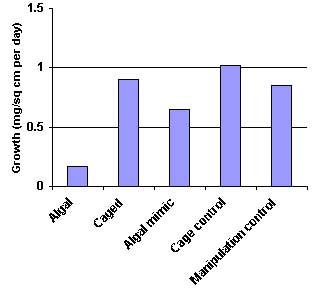Algae are a diverse group of photosynthetic organisms. They share the following characteristics:
- photosynthetic system based on chlorophyll a
- reproductive structures lack sterile cells, i.e. all cells are potentially fertile
- do not form embryos, i.e. parents do not form embryo within protective coverings
Algae are important producers of oxygen and organic material in the oceans and freshwater environments. They range in size from microscopic single cells to large, multi-cellular seaweeds that can reach up to 100 ft in length.
Planktonic algae are free-floating in the water, thus composing the phytoplankton community of an aquatic environment.
Benthic algae attach themselves to a substrate (i.e. hard surface such as rock, sunken ship, dead coral, and even other live organisms) via a holdfast. They can be small, single-celled or large macrophytes. Algae with their individual body structures readily visible are called macroalgae.
Macroalgae can be filamentous, encrusting, or fleshy.
Figure 1 shows the change in total algae covering shallow sea floor around Jamaica from 1977 to 1993. There was a dramatic increase in algal cover in 1986, and persisted until the early 90s.
- What could have caused the sudden increase in algal cover?
- Compare these results with coral cover findings from the same study.
|
Here are results from a study examining Diadema antillarum recovery, macroalgae cover, and coral abundance at five sites in Discovery Bay, Jamaica during January 2000. In this graph, researchers compared the percent of macroalgae covering the sea floor in urchin or algae zones at each site.
The results show that macroalgae cover less than 10% of the sea floor in urchin zones.
- What is present at the urchin zones that could keep macroalgae cover low?
- Compare this result with coral and sea urchin abundance in these areas during the same study.
A 16-day experiment was conducted in Discovery Bay, Jamaica to investigate coral and macroalgae competition in a tropical reef environment. The study specifically investigated competition between the tall and bushy macroalga Sargassum hystrix and the branching coral Porites porites.
This experiment had five treatments (diagram), and each treatment was replicated 10 times. Blue dot = coral; Red "x" = macroalgae; Brown square = algal mimic (made from plastic sheets); Black lines = three-sided, wire cage.
(Figures created from data presented in River and Edmunds, 2001)
Observations of polyp behavior:
- P. porites adjacent to S. hystrix in treatment, and in adjacent reef community, frequently had some or all of their polyps contracted
- Coral not in contact with macroalgae had expanded polyps most of the time.
|
|
Figure 4 is a histogram comparing the light levels recorded in each treatment. Light sensors were used to determine the amount of light the coral polyps received in each treatment situation.
Light was reduced by 40% in the algal and caged treatments compared to the manipulation control. This suggests that presence of the macroalgae reduced the amount of light the coral received.
- What can you infer about macroalgae and coral competition based on the results presented here?
- How do these results relate with what is happening to the coral reef community in Jamaica?
|
This web site was created by Lynn Tran at the North Carolina State University, Department of Mathematics, Science, and Technology Education on 7/12/03. Faculty advisor Dr. David Eggleston, NCSU, Department of Marine, Earth, & Atmospheric Sciences. Last updated December 29, 2003 .




